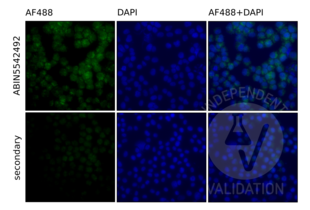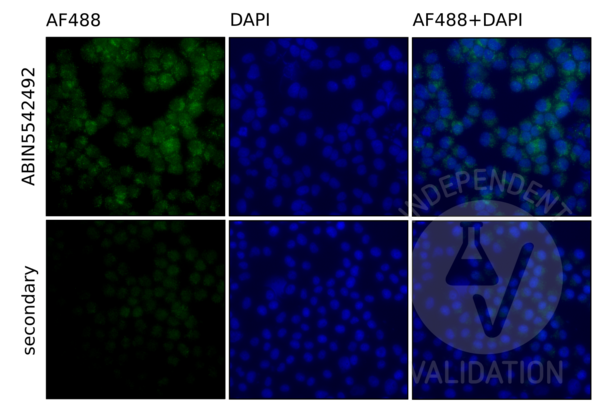TLR9 Antikörper

 TLR9 Antikörper (AA 868-1016) (ABIN5542492)
TLR9 Antikörper (AA 868-1016) (ABIN5542492)
TLR9 Reaktivität: Human WB, IHC, ELISA, FACS, ICC Wirt: Maus Monoclonal 1B12H2 unconjugated
TLR9 Reaktivität: Human WB, IHC, ICC, IP Wirt: Kaninchen Polyclonal unconjugated
TLR9 Reaktivität: Human WB, IHC, ELISA, FACS, ICC, Neut Wirt: Maus Monoclonal 5B10E8 unconjugated
TLR9 Antikörper nach Wirt
Hier sind TLR9 Antikörper mit einem spezifischen Wirt zu finden. Die hier aufgeführten Wirt sind einige der verfügbaren. Ein Klick auf den entsprechenden Link führt zu den Produkten.
TLR9 Antikörper nach Klonalität
Finden Sie verfügbare monoklonale oder polyklonale TLR9 Antikörper. Klicken Sie auf einen Link, um zu den entsprechenden Produkten zu gelangen.
TLR9 Antikörper nach Konjugat
Suchen Sie TLR9 Antikörper mit einer bestimmten Konjugation wie FITC, Biotin, PE. Die unten aufgeführten Konjugate gehören zu den verfügbaren. Klicken Sie auf einen Link, um zu den entsprechenden Produkten zu gelangen.
Häufig verwendete TLR9 Antikörper
- (7)
- (2)
- (8)
- (4)
- (4)
- (1)
- (2)
- (7)
- (2)
- (3)
- (3)
- (7)
- (2)
- (7)
- (2)
- (2)
- (2)
- (2)
- (1)
- (1)
- (2)
Aktuelle Publikationen für unsere TLR9 Antikörper
: "Differential expression patterns of Toll Like Receptors and Interleukin-37 between calcific aortic and mitral valve cusps in humans." in: Cytokine, Vol. 116, pp. 150-160, (2019) (PubMed).: "Co-expression of TLR-9 and MMP-13 is associated with the degree of tumour differentiation in prostate cancer." in: International journal of experimental pathology, Vol. 100, Issue 2, pp. 123-132, (2019) (PubMed).
: "A proliferation-inducing ligand (APRIL) induced hyper-production of IgA from tonsillar mononuclear cells in patients with IgA nephropathy." in: Cellular immunology, Vol. 341, pp. 103925, (2019) (PubMed).
: "Necroptosis in pulmonary macrophages mediates lipopolysaccharide-induced lung inflammatory injury by activating ZBP-1." in: International immunopharmacology, Vol. 77, pp. 105944, (2019) (PubMed).
: "Genistein modulates the expression of Toll-like receptors in experimental autoimmune encephalomyelitis." in: Inflammation research : official journal of the European Histamine Research Society ... [et al.], Vol. 67, Issue 7, pp. 597-608, (2018) (PubMed).
: "Elevated intragraft expression of innate immunity and cell death-related markers is a risk factor for adverse graft outcome." in: Transplant immunology, Vol. 48, pp. 39-46, (2018) (PubMed).
: "High Tidal Volume Induces Mitochondria Damage and Releases Mitochondrial DNA to Aggravate the Ventilator-Induced Lung Injury." in: Frontiers in immunology, Vol. 9, pp. 1477, (2018) (PubMed).
: "Toll-like receptors 2, 4 and 9 and hypoxia markers HIF-1alpha and CAIX in pancreatic intraepithelial neoplasia." in: APMIS : acta pathologica, microbiologica, et immunologica Scandinavica, Vol. 126, Issue 11, pp. 852-863, (2018) (PubMed).
: "Impaired Surface Expression of HLA-DR, TLR2, TLR4, and TLR9 in Ex Vivo-In Vitro Stimulated Monocytes from Severely Injured Trauma Patients." in: Mediators of inflammation, Vol. 2017, pp. 2608349, (2017) (PubMed).
: "High toll-like receptor (TLR) 9 expression is associated with better prognosis in surgically treated pancreatic cancer patients." in: Virchows Archiv : an international journal of pathology, Vol. 470, Issue 4, pp. 401-410, (2017) (PubMed).
Aliase für TLR9 Antikörper
toll like receptor 9 (TLR9) Antikörpertoll-like receptor 9 (Tlr9) Antikörper
CD289 Antikörper
Haben Sie etwas anderes gesucht?
- TLR8 Antikörper
- TLR7 Antikörper
- TLR6 Antikörper
- TLR5 Antikörper
- TLR4 Antikörper
- TLR3 Antikörper
- TLR2 Antikörper
- TLR13 Antikörper
- TLR12 Antikörper
- TLR11 Antikörper
- TLR10 Antikörper
- TLR1 Antikörper
- TLN2 Antikörper
- TLN1 Antikörper
- TLL1 Antikörper
- TLK2 Antikörper
- TLK1 Antikörper
- TLE6 Antikörper
- TLE4 Antikörper
- TLE3 Antikörper
- TLX1 Antikörper
- TLX2 Antikörper
- TLX3 Antikörper
- TM2D1 Antikörper
- TM2D2 Antikörper
- TM2D3 Antikörper
- TM4SF1 Antikörper
- TM4SF18 Antikörper
- TM4SF20 Antikörper
- TM4SF4 Antikörper
- TM4SF5 Antikörper
- TM6SF1 Antikörper
- TM7SF2 Antikörper
- TM9SF1 Antikörper
- TM9SF2 Antikörper
- TM9SF4 Antikörper
- TMBIM1 Antikörper
- TMBIM4 Antikörper
- TMC1 Antikörper
- Tmc2 Antikörper




